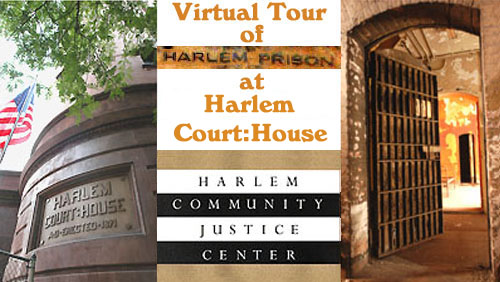
The HCJC logo was the only image on the HCJC Youth Justice fact sheet given to visitors. All framed images on this web page originated as digital photos by Gerald Schultz.
[Click logo of HCJC for its web site.]
|
|
HCJC-provided overview continues from NYCHS presentation's previous page.
• Youth Futures Network is a coalition of community organizations, residents and justice agencies working to reduce and prevent substance abuse among youth in East Harlem by strengthening protective/resiliency factors among young people in the community at risk for substance abuse.
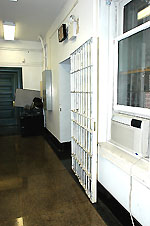
Bars of door to jail painted white.
[Click small image to access medium sized version.]
|
|
The Justice Center, which has been a leader in the development of the coalition, has supported and helped to implement a variety of community responses and strategies by increasing access to substance abuse services for youth and families, by involving the faith community in substance abuse prevention efforts and through the creation of internships, job training opportunities and academic assistance to East Harlem youth.
• Harlem Hard H.A.T.S -- Harlem Hard H.A.T.S. is the Justice Centerís youth service program where young people plan and implement community service projects.
Hard H.A.T.S. is a youth development tool that reinforces positive values such as honesty, responsibility, self-discipline, and respect for and service to others.

Less ornate stairs.
[Click small image to access medium sized version.]
|
|
In addition to maintaining primary responsibility for the restoration and keeping of an East Harlem neighborhood park, the Hard HATS crew has contributed hundreds of hours of community service towards specific projects.
The following are several examples.
Recently, the members of Harlem Hard HATS participated in the AIDS Walk New York. Their preparation began with a series of workshops about HIV/AIDS lead by guest speakers and Justice Center staff, moved into discussions about the disproportionate impact of HIV/AIDS on their community in particular, and finally turned to ways they might address the problem themselves.
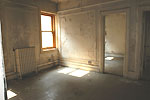
Former living quarters.
[Click small image to access medium sized version.]
|
|
The young people solicited hundreds of donations--in apartment buildings, project housing, churches, community centers, grocery stores, and schools-adding up to a contribution of over $3,000. The youth walked all ten kilometers of the AIDS Walk under the Harlem Community Justice Center banner.
As part of a Media Literacy unit, participants underwent extensive training in a wide variety of media - from newspaper reporting to television commercials, print advertisements to popular music - led by both Youth Justice Project staff and guest speakers with years of experience in the field.
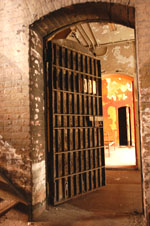
Heavy plated door with bars leads to cells.
[Click small image to access medium sized version.]
|
|
Having developed critical thinking and creative skills in the workshop process, the participants used their understanding of effective media principles and strategies to design their own ad campaigns around issues of violence, drugs, and HIV/AIDS in the community.
One of the most effective features of their campaigns (other than the sense of urgency and inventiveness they brought to the task) is the fact that they themselves are members of their target audience: young people from East and Central Harlem at risk for precisely the behaviors they are addressing in their media projects.
Currently, the Hard HATS participants are focusing on issues of housing and homelessness in the community.
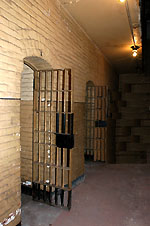
Cell doors and doorways.
[Click small image to access medium sized version.]
|
|
Having visited several neighborhood renewal projects around the city, studied urban planning and public housing policy, participated in their own park clean-up and renovation, and discussed extensively the root causes and consequences of housing struggles in Harlem, the young people selected two projects.
The first of those was the New York Cares Coat Drive, and through a series of flyers, letters, and door-to-door efforts, the young people collected coats to donate to those in need.
They then went down to the New York Cares warehouse, and in one day, sorted over 4,000 coats and almost as many articles of clothing.

Looking inside the cells.
[Click small image to access medium sized version.]
|
|
Alongside this project, the participants have been working to develop their own CD-a compilation of poetry, hip-hop, and factual information about housing and homelessness--in the hopes of educating those around them and empowering their listeners to make a positive difference in Harlem.
The HCJC-provided overviewcontinues on next page
of this NYCHS
presentation.
